![]()
![]()
![]()
Use LEFT and RIGHT arrow keys to navigate between flashcards;
Use UP and DOWN arrow keys to flip the card;
H to show hint;
A reads text to speech;
108 Cards in this Set
- Front
- Back
|
What is the rest mass of an electron? |
0.51 MeV
|
|
|
Is an alpha particle charged? If so, what charge does it carry?
|
Yes, +2
|
|
|
Is a positron charged? If so, what charge does it carry?
|
Yes, +1
|
|
|
Is a neutron charged? If so, what charge does it carry?
|
No
|
|
|
Is neutrino charged? If so, what charge does it carry?
|
No
|
|
|
Assuming equivalent energy, place the following particles in order of increasing LET:
Neutrons Alpha particles Electrons |
Electron
|
|
|
What is the rest mass of a proton?
|
930 MeV (~1 amu)
|
|
|
What is the rest mass of a neutron?
|
930 MeV
|
|
|
Which of the following particles are directly ionizing?
Protons Neutrons Positrons Alpha particles Beta rays |
All are directly ionizing with the exception of neutrons, which are not charged.
|
|
|
131Iodine and 125Iodine:
A. Have different chemical properties. B. Have different Z values. C. Occupy different columns on the periodic table. D. Have the same number of neutrons. E. None of the above. |
E. I-131 and I-125 are isotopes i.e. they have the same Z value. Their chemical properties are thus the same. They do NOT, however, have the same number of neutrons.
|
|
|
If a radionuclide decays by beta minus emission or positron emission, the resultant daughter nuclei will be iso_______.
|
Isobars
|
|
|
In Co-60, the number 60 represents what?
|
The number of nucleons i.e. the MASS number (A).
NB: For Co-60, Z=27 |
|
|
In standard notation, what does Z represent?
|
Number of protons in an atom. The ATOMIC number
NB: A is the mass number |
|
|
1 MeV = ________ eV
|
10^6 eV
Ex: 930 MeV (mass of a proton) is approximately 1000 MeV or 10^9 eV (1000 x 10^6) |
|
|
Avogadro's Number
What does it represent? What is the constant? |
Number of atoms of a substance in a mole.
6.02 x 10^23 mol^-1 |
|
|
Equation relating half-life and decay constant
|

Where T1/2 is half life and lambda is decay constant.
|
|
|
Half life of Ir-192
|
74 days
|
|
|
What is the mean life of a radioisotope? (definition)
|
The amount of time the radioisotope would take to decay if the initial activity were constant
Mean life = 1.44 (half life) NB: Denoted by tau |
|
|
Alpha Decay: What are the products? How do the atomic and mass numbers change?
|

The only products are a daughter nuclide and a helium.
A-4 Z-2 NB: For any given radioisotope, the energy of the emitted alpha particle is always the same. |
|
|
Internal conversion
|
A way of stabilizing an excited nucleus. Excess energy is transferred directly from the nucleus to an electron, which is ejected. The resultant vacancy is then filled by a cascade, which may result in characteristic x-rays and/or Auger electrons.
|
|
|
Beta-minus decay
|

Occurs in proton-poor nuclei. A neutron is converted into a proton, electron and antineutrino.
A remains the same, Z increases by one (Z + 1) |
|
|
Beta-plus decay (positron decay)
|

Occurs in proton-rich nuclei. A proton is converted to a neutron, positron and neutrino.
A remains the same, Z decreases by one (Z-1) |
|
|
Electron capture
|

More likely to occur in proton-rich, heavy nuclei. The unstable nucleus grabs an inner shell electron, which combines with a proton to become a neutron. A neutrino is kicked out.
A remains the same, Z decreases by one (Z - 1) |
|
|
Define: Radioactive Equilibrium
|
When the radiation of the activity of a daughter nuclide to the activity of its parent approaches a constant value
|
|
|
Secular Equilibrium
|
Occurs when the half-life of a daughter nuclide is much shorter than the half-life of the parent. The activity of the daughter and parent are roughly equal.
Td< Ex: Sr-90 (half-life 28 yrs) decays into Y-90 (half-life 64 hours) |
|
|
Transient Equilibrium
|
Occurs when the half-life of a daughter nuclide is somewhat shorter than the half-life of its parent
Td~ Ex: Mo-99 (half-life 66.7 hours) decays to Tc-99m (half-life 6.03 hrs) |
|
|
Name four ways of creating radioisotopes
|
1) Naturally occurring
2) Byproduct of nuclear fission 3) Produced in a reactor via neutron bombardment 4) Exposed to a charged particle beam in an accelerator |
|
|
Which radioisotopes are created via nuclear fission?
|
Cs-137, I-131, Sr-90
|
|
|
Which radioisotopes are created via neutron bombardment?
|
Co-60, I-125, Ir-192, Pd-103
|
|
|
What is the SI unit of activity?
|
Becquerel = 1 decay/sec
|
|
|
Curie
|
1 Ci = 3.7 x 10^10 Bq
Old unit of activity (NOT SI) NB: 1 mCi = 37 MBq |
|
|
What is the equation for calculating activity over a period of time, t?
|

where Ao is the activity at time 0, t is time elapsed and lambda is the decay constant.
|
|
|
How would you calculate activity if you know the number of half-lives that have elapsed?
|

where Ao is the activity at time 0 and n is the number of elapsed half-lives.
|
|
|
Use factor: Definition and representative values
|
The fraction of time that the beam is pointed at a given barrier
Secondary barrier: 1 (leakage and scatter) Floor=0.31 Wall=0.21 Ceiling=0.26 |
|
|
Occupancy factor: Definition
|
The fraction of a treatment day during which the area is occupied
|
|
|
Occupancy (T): Representative values
|
T=1 (full occupancy): Work areas, nurses' station, clinic, console
T=/15 (Partial occupancy): Hallways, staff restroom, employee lounge T=1/20 (Occasional occupancy): Public restrooms, lobby, storage areas T=1/40 (Transient occupancy): Stairways, elevators |
|
|
Workload: Definition
|
The number of patients treated per WEEK* the dose equivalent delivered per patient at a distance of 1 m
|
|
|
Per regulations, how much leakage is allowed from the head of a linac?
|
No more than 0.1% of the useful dose rate at 1 m
|
|
|
For safety purposes and shielding, where are radiation levels calculated or measured?
|
1 foot beyond the outside surface of a shielded wall
|
|
|
Barrier transmission factor (B): Definition
|
The multiplicative factor by which the radiation level must be reduced so that it matches the design limit (P)
|
|
|
With regard to room shielding, how do you solve for the required barrier transmission factor (Bp) for a primary barrier?
|

where P is the allowable weekly dose in Sievert, W is workload, T is occupancy, U is use factor and d is the distance from the source to the protection point (in METERS)
This is only for the primary barrier. |
|
|
With regard to room shielding, how do you solve for the leakage barrier transmission factor (BL) for a secondary barrier?
|

where P is the allowable weekly dose in Sievert, dL is the distance from the isocenter to the protection point, W is workload and T is occupancy.
W is multiplied by 0.001 to reflect the fact that regulations allow 0.1% of the useful dose via leakage. |
|
|
1 Sv = ______ rem
|
100 rem
|
|
|
What is a radiation weighting factor? What's it used for?
|
Used in calculating equivalent dose for various particles.
|
|
|
What is the radiation weighting factor (Wr) for x-rays? Electrons? Neutrons? Alpha particles?
|
Xrays and electrons: Wr=1
Neutrons: Wr=20 (dpdt on energy) Alpha particles: Wr=20 |
|
|
What is a deterministic effect? Examples?
|
Effects that increase in severity with increasing dose above a given threshold
Ex: Skin erythema, hair loss, cataracts, fibrosis |
|
|
What is a stochastic effect? Examples?
|
The probability of the effect increases with dose; however, the severity of the effect does not. All or nothing.
Ex: Carcinogenesis, genetic effects |
|
|
A medical event occurs. What sort of documentation is required?
|
1) Notify the NRC within 24 hours by phone
2) Submit a written report within 15 days 3) Notify the patient and the referring physician within 24 hours |
|
|
What constitutes an NRC medical event?
|
1) Total dose differs by 20% or more
2) A single dose within a fractionated regimen differs by 50% or more 3) Wrong patient 4) Wrong mode of treatment 5) Leaking sealed source 6) Dose to the wrong site that exceeds 500 mSV and 50% of the prescribed dose |
|
|
LD50 for humans
|
4 Gy to the whole body (without medical intervention)
|
|
|
Effective dose for a CXR? CT?
(in mSv) |
Chest x-ray: 0.1 mSv
CT: 10 mSv |
|
|
What is the average annual effective dose to the public? Daily dose? How much is natural?
|
6.2 mSv/year
0.017 mSv/day About half is due to medical procedures and half is naturally occurring. |
|
|
Define: Effective dose
|
The dose received, taking into account the radiation sensitivities of various organs and tissues
He = Ht x Wt where Ht is the mean equivalent dose and Wt is the tissue weighting factor |
|
|
Define: Equivalent dose
|
The dose absorbed, taking into account the type and energy of the radiation
Ht = Dt x Wr where Dt is the average absorbed dose in a tissue and Wr is the radiation weighting factor Ex: Wr for neutrons is 20 |
|
|
What is the excess lifetime risk of developing a fatal cancer due to a given dose of radiation?
|
The risk is 4 in 100 per Sievert i.e. 4x10^-2 per Sv effective dose
Ex: A chest xray delivers 10 mrad to the lungs only. Equivalent dose = 10 mrad * 1 (weighting factor of xrays) = 10 mrem Effective dose = (10 mrem)(1 rem/1000 mrem)(1 Sv/100 rem)(0.12) = 1.2 x 10^-5 Sv (1.2 x 10^-5 Sv)(4x10^-2 risk/Sv) = 5x10^-7 |
|
|
What units are associated with an exposure rate constant?
|

|
|
|
What is the equation relating exposure and charge?
|
X = Q/m
where X is exposure, Q is the charge collected and m is the mass of the air in the sample volume |
|
|
At what energy do free air ionization chambers become impractical?
|
Above 3 MeV. The plate separation and chamber size required to maintain equilibrium is too big to be practical.
|
|
|
For each of the following devices, is it an absolute or relative dosimeter?
Free air ionization chamber Calorimeter |
Free air ionization chamber: Absolute (exposure)
Calorimeter: Absolute (dose) |
|
|
What is standard temperature and pressure?
|
22 C (295 K) and 760 mm-Hg
|
|
|
How do you convert Celsius to Kelvin?
|
Add 273
|
|
|
How do you calculate a temperature and pressure correction factor?
|

where STP are 295 K and 760 mm-Hg. T is in Celsius.
|
|
|
Geiger-Muller Counters: What can they detect? On what principle are they based? What are they good for?
|
GM counters work on the principle of gas amplification, making them very sensitive. They can detect a single charged particle but canNOT discriminate energy. GM counters do have refractory period, or "resolving time," which can cause spuriously low counts in a high radiation field. They are best used for locating lost sources or detecting radioactive contamination.
|
|
|
What are the advantages of TLDs as an in vivo dosimeter?
|
Small
No wires Reusable Can be used over a wide dose range (less than a cGy up to 10 Gy?) Near tissue equivalence (if using LiF) Nearly linear relationship between dose and response up to ~3-4 Gy |
|
|
What are the disadvantages of a TLD?
|
Delayed reading, can only be read once (so write it down!)
|
|
|
What is the formula for optical density?
|

|
|
|
Diodes: Benefits? What can they be used for?
|
Advantages: Very sensitive, rugged, reliable, real-time readout
Uses: Daily machine output constancy, pt dosimetry NB: canNOT be used for beam calibration |
|
|
MOSFETs: Advantages? Uses?
|
Advantages: Small, lightweight, reusable
Disadvantages: Shorter lifetime than a diode Uses: Patient dosimetry |
|
|
Film Dosimetry: Benefits? Disadvantages?
|
Advantages: High spatial resolution, creates a permanent record, widely available, relatively cheap
Disadvantages: Has to be developed, not tissue equivalent, energy dependent, sensitive to light |
|
|
Define: Electron stopping power
|
Energy lost per unit path length in the medium (dependent on density)
Units = MeV/cm |
|
|
Define: Mass Stopping Power (electrons)
|
Energy loss per unit path length in the medium divided by density i.e. stopping power divided by density
Units = MeVcm2/g |
|
|
How are electrons beams defined?
|
R50 i.e. the depth (cm) at which the dose is 50% of the maximum
|
|
|
How do you calculate the electron energy at a given depth?
|
Ez = Eo[1-(z/Rp)]
where Ez is the energy at depth z, Eo is the incident electron energy and Rp is the practical range of the given electron energy (~energy/2) |
|
|
Rule of thumb for blocking electrons with Pb
|
The minimum thickness (in mm)= incident energy/2
|
|
|
A photon and electron field abut. Describe the distribution of hot and cold spots.
|
Hot spot in the photon field due to greater scattering of the electrons.
Cold spot in the electron field |
|
|
What is the minimum ICRU-recommended field size for an electron field?
|
An electron field cutout should be at least as large as the electrons' practical range to achieve lateral scatter equilibrium
i.e. Minimum field size > Rp = E/2 |
|
|
How do photon and proton dose distributions differ?
|
Photons: Superior skin sparing, more forgiving of changes in target position and inhomogeneity
Protons: Generally lower integral dose (no exit dose), smaller lateral penumbra, fewer beams usually used, can use "patch fields" given the lack of exit dose |
|
|
What is the typical maximum range of a proton therapy beam?
|
30 cm (corresponding to an energy of 23-240 MeV)
|
|
|
What is the typical maximum energy of a therapeutic proton beam?
|
~250 MeV
|
|
|
In PET, what is actually detected to produce the image?
|
511 keV (0.511 MeV) photons
- These are created via an annihilation reaction between a position and electron. |
|
|
Per NRC CFR Part 20 and 10 CFR Part 35, how often does a radiation shielding survey of adjacent areas need to be conducted for an I-192 source?
|
Whenever the source is changed in the HDR unit.
|
|
|
Exposure
|
- Measure of the ability of photon radiation to ionize air
- DEFINED ONLY FOR AIR AND PHOTONS - Units: R or C/kg (SI) - Only practical under 3 MeV (due to the limitations of ionization chambers) |
|
|
Roentgen
|
- Unit of exposure
- NOT SI - Equals 2.58 x 10^-4 C/kg |
|
|
Equation for Exposure
|
X=Q/m
where X is exposure, Q is the electrical charge produced in air, and m is mass in kg |
|
|
A photon beam has an energy of 6 MV. What does this mean? What is the maximum and average energy produced?
|
A 6x beam is produced using a stream of 6 MeV electrons. The maximum photon energy produced is thus 6 MV with an average energy of 2 MV (~energy/3).
|
|
|
What is a typical dose rate for an EBRT treatment?
|
200-600 MU/minute
Higher for SBRT and SRS |
|
|
What roles do a linac monitor ion chamber serve?
|
1) Provide feedback to maintain a constant dose rate
2) Track the total or integrated dose i.e. total MU delivered 3) Monitor beam flatness and symmetry |
|
|
Where is the collimator-produced field size defined? i.e. where is it measured?
|
At SAD (usually 100 cm)
|
|
|
How much radiation is transmitted through the movable jaws of the collimator?
|
<=0.5%
|
|
|
Half-life of Co-60
|
5.26 years
|
|
|
How does Co-60 decay?
|
Beta-minus
|
|
|
For Co-60 units, how often should the timer error be measured?
|
Monthly (NRC regulation)
|
|
|
A collimator is set to a field size of 20x20 cm. How large is the field at a depth of 30 cm?
|
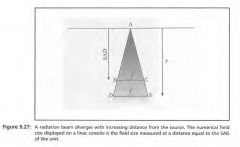
Collimator field size is defined at isocenter (100 cm)
fr = f x r/SAD fr = 20 x (30 cm/100 cm) = 6 cm |
|
|
You are given a beam profile. How is the field size defined?
|
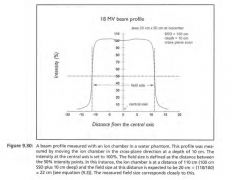
The field size is defined as the distance between the 50% intensity points. In the example below, the ion chamber is at 110 cm (not isocenter), so the field size needs to account for this.
Beam profile field size = Isocenter field size(r/SAD) 22 cm = f(110 cm/100 cm) f = 20 cm |
|
|
Over what portion of a beam profile is flatness assessed?
|
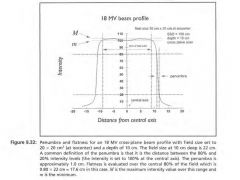
Inner 80%
NB: It would be unrealistic to expect the beam edges to be completely flat. |
|
|
Equation for beam flatness
|

NB: This is ONE definition of many. Tolerance is generally +/-3%
|
|
|
Name three sources of penumbra
|
1) Non-point source (ex: Co-60)
2) Transmission penumbra: collimator jaws or blocks 3) Scattered photons and secondary electrons |
|
|
Define: physical penumbra
|
- The measured penumbra, incorporating all possible causes, including geometric, transmission and scatter
- Commonly defined as the lateral distance between the 80% and 20% intensity levels in a beam profile measured at a depth of 10 cm using a 10x10 cm2 field |
|
|
How does field size affect scatter?
|
- Direct relationship
- As field size increases, more matter is irradiated --> increased scatter |
|
|
Dmax of Co-60
|
0.5 cm
|
|
|
Dmax of a 10x beam
|
2.5 cm
|
|
|
Dmax of a 15 MV beam
|
3 cm
|
|
|
Dmax of a 6x beam
|
1.5 cm
|
|
|
Dmax of an 18 MV beam
|
3.3 cm
|
|
|
How does depth dose change with beam energy?
|
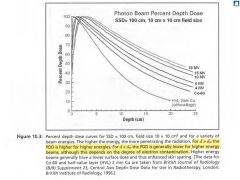
With increasing beam energy:
1) Deeper dmax 2) Greater skin sparing 3) Higher PDD for a given depth when d>dmax 4) Usually LOWER PDD for a given depth when d |
|
|
Define: Mayneord f factor
|

- Factor used to convert between two PDDs with different SSDs
- F is >1 when the second SSD is larger than the first (bc PDD increases with SSD) - In the equation below, dm is dmax. |
|
|
Formula: Equivalent Circle
|

Set the area of a circle and square equivalent to each other -->
Radius = Equivalent square/sqrt(pi) |
|
|
Draw a diagram of a TAR set-up.
|
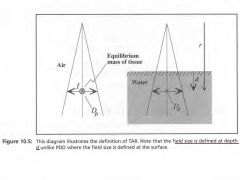
|

